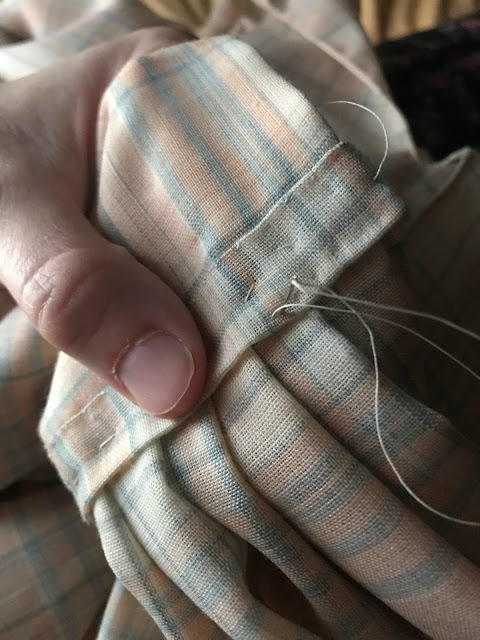Two days before the fashion show and this was my to-do list for finishing my sheer wool 1810’s gown, now that all the trim was done:
~ bind the neckline and sleeve cuffs
~ pleat and attach the skirt
~ drawstrings in the neckline and waistline casings
~ closures of some sort
Oh, and a bonnet. That needed to be finished too. But that’s another story.
The neckline and cuffs were bound in strips of fabric cut on the straight of grain. Bias cut strips are much easier to bind curved edges, such as necklines, with, but bias bindings were rarely, if ever, used in the 18th or early 19th centuries. On-grain bindings are a much more economical use of expensive fabric.
So, in the interest of accuracy, straight grain bindings it was!
Once the neckline binding was on, I threaded a piece of 1/4” cotton twill tape through it as the drawstring.
~ Bind neckline and cuffs ✔️
Onto the skirt!
I removed all my basting threads from the skirt trim, and then proceeded to pleat the skirt onto the bodice.
I used knife pleats all along the back of the skirt, and the front of the skirt is left flat.
Once it was pinned on, I hand sewed the skirt to the bodice using a prick stitch.
The seam allowance was then covered in a piece of 1/2” cotton twill tape.
This formed a casing for the waistline drawstring - made from 1/4” twill tape just like the one in the neckline.
~ Pleat and attach the skirt ✔️
~ Drawstrings in the neckline and waistline ✔️
At this point it was the evening before the fashion show and I had a friend over for dinner. I tried on the dress so my friend could help me figure out how much the back could overlap before I sewed on the hooks and eyes.
Turns out I’d gained a bit of weight since fitting the mockup 6 weeks earlier, and there was no overlap to be had. The edges barely met at all.
Thus, I sewed the hooks and eyes right at the edges of the back opening. The back would gap, displaying my bodiced petticoat, but atleast it would be fastened.
~ Closures of some sort ✔️
The dress was done! I just needed to trim my bonnet then I could go to bed and be well-rested for the fashion show the next day.
After using my one white Regency dress for anything and everything Regency for the past 6 years it was a thrill to have a new early 1800’s dress to wear!
And such a distinctive style rather than just another “plain white regency dress”.
I was definitely a bit disappointed that I had to resort to the sewing machine for the skirt trim - but when the dress is worn it’s really not obvious.
It’s just so nice to finally have this dress done and wearable after years of planning and dreaming!
What the item is: 1810’s sheer wool dress
The Challenge: Perfect 10 - it’s from the 1810’s and there are 10 rows of gathered trim, 2 around the neck, 2 on each sleeve cuff, and 4 on the skirt.
Material: A sheer wool/nylon blend. It’s about 90% wool, so mostly wool and has a wool texture. The lining is cotton. Silk was used for the piping on the trim.
Pattern: I scaled up the 1813-1816 Morning Dress pattern from “Regency Women’s Dress” by Cassidy Percoco
Year: I based my dress on one from 1811 that I found on Pinterest and used an 1813-1816 pattern. So it would be suitable for most of the 1810’s.
Notions: Cotton cording, thread, hooks and eyes
How historically accurate is it? Sheer wool was often used for dresses of the era, but the nylon in mine brings down the accuracy a bit. A cotton lining is alright, though linen would be better. The pattern is accurate. The bodice was constructed by hand using period techniques, but the skirt and sleeves were machine sewn. It would be recognizable in the era I think. So 60-70%
Hours to complete: I’m not sure, I spent about 6 weeks working on this, and usually did atleast an hour of sewing per day.
First worn: September 3, 2022, for a Regency Era fashion show
Total cost: I believe I spent $5 per yard on this fabric several years ago. I think I got about 6 yards, so that’s $30. The notions were all from stash, the cotton and silk I got really cheap 2nd hand. So $35ish.

















Very Jane Austin like. :-) So lovely!
ReplyDeleteVery lovely! That's such nice fabric. I also love the attention and detail in the trimming. Those are some great ideas, and it turned out really well! I love your historical projects. I recently got some wool for a Regency Royal Navy-styled spencer, and I can't wait to get working on it!
ReplyDelete-Erin
Really professional design and construction job. The fabric looks so appropriate for this design, for spring wearing. So beautiful! Thank you so much for posting your work!
ReplyDelete